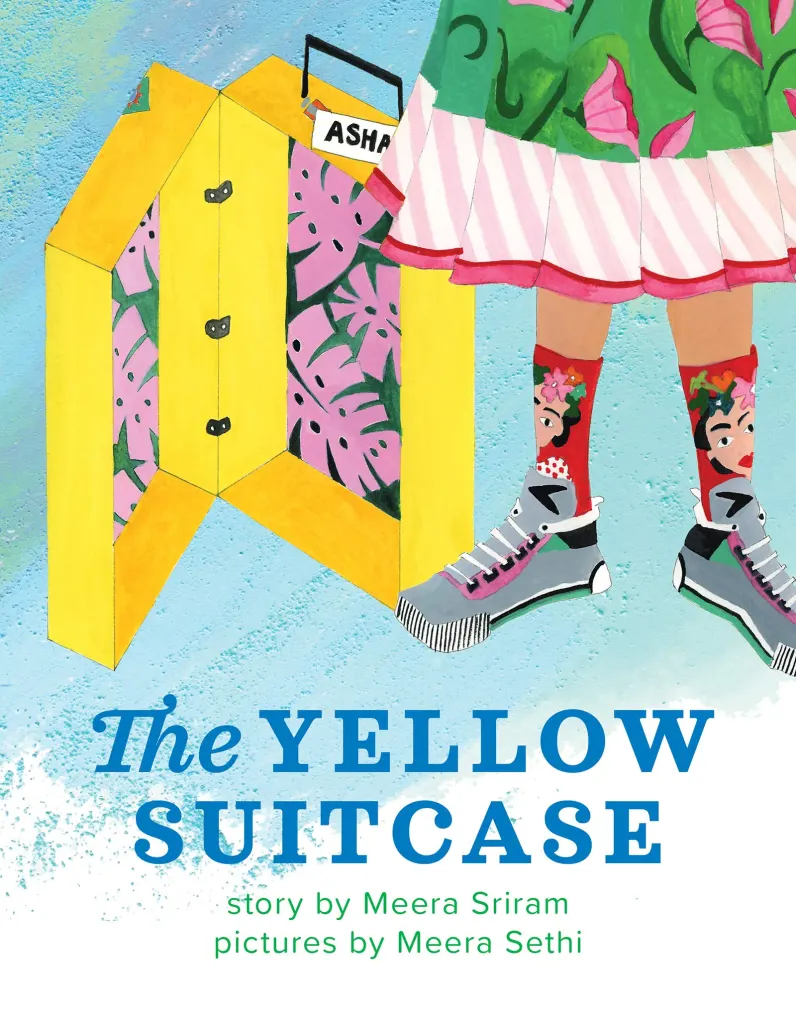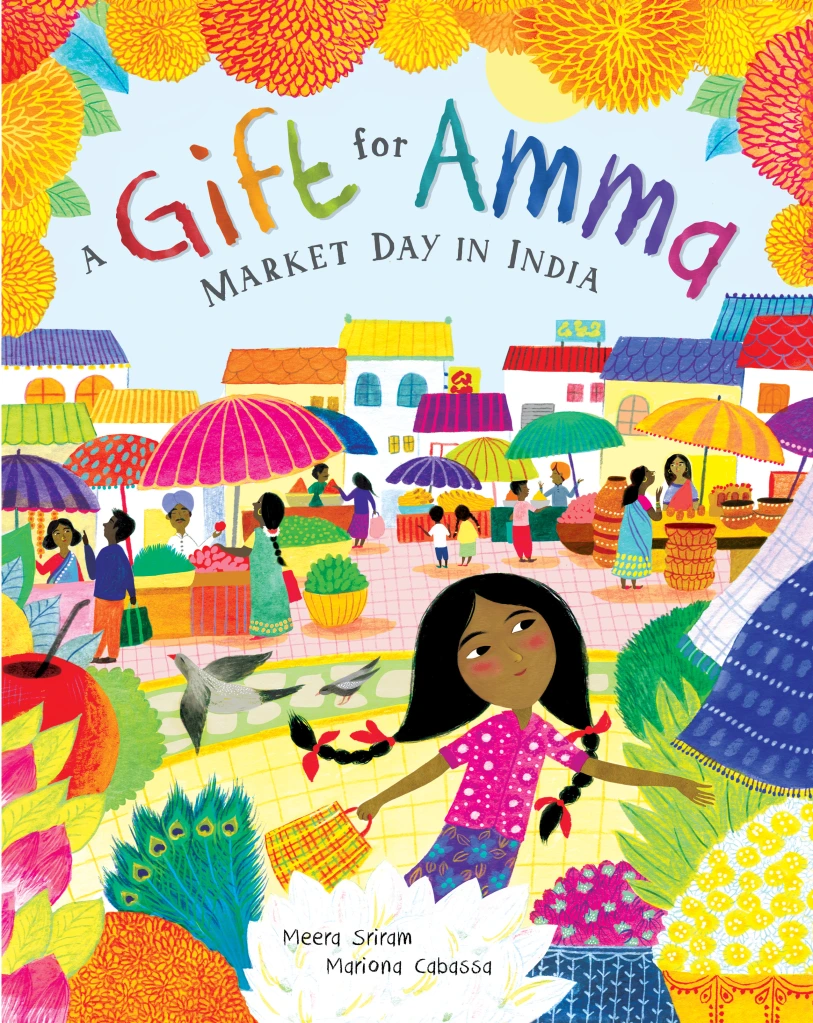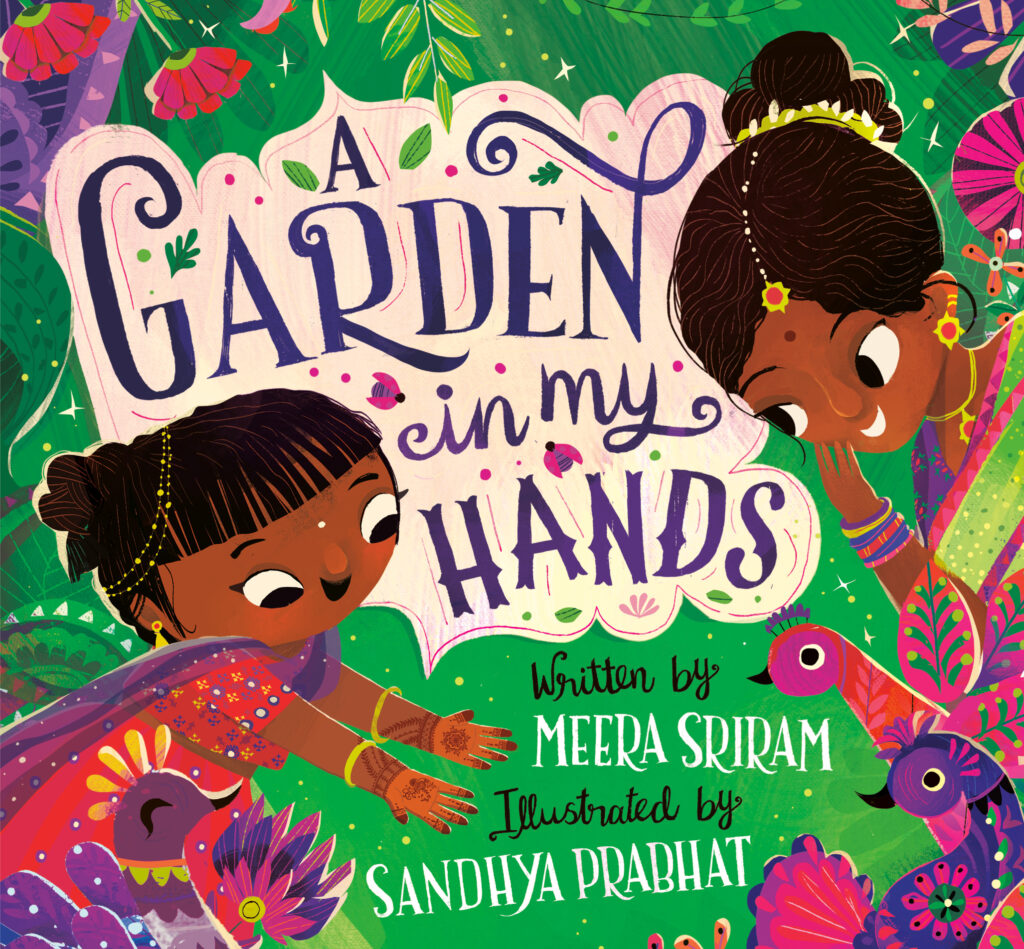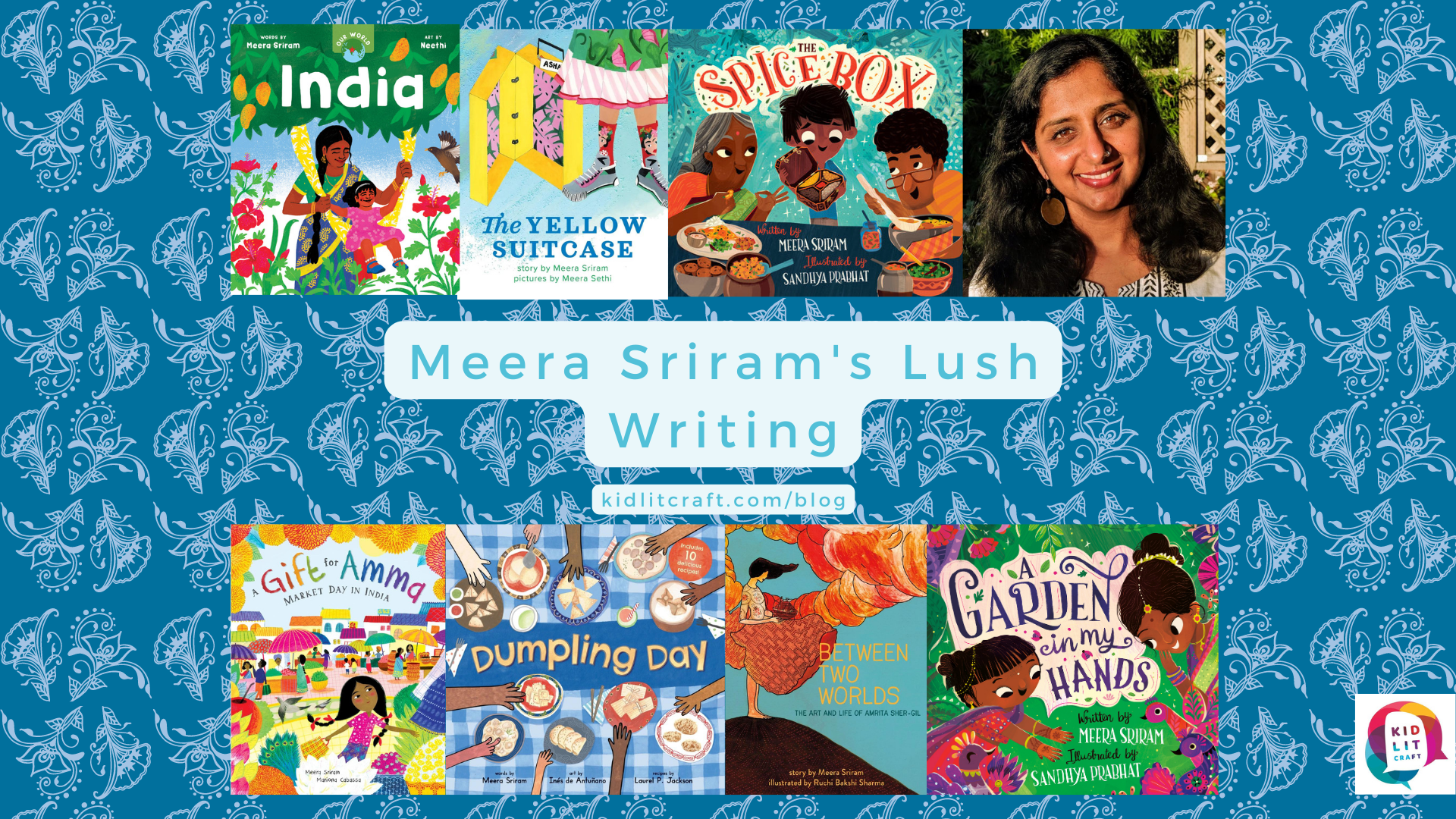craft review by Kristi Wright
A well-written picture book can be a master class in evocative writing. And Meera Sriram has published five picture books that demonstrate this. Her superpower is making her stories feel lush, with her books providing a sensory and emotional experience that culminates in a satisfying payoff. In this post, we’ll look at three of her picture books for some of the methods she uses.
NOTE: While we’re focused on the techniques Sriram uses in her text, I can’t say enough about how beautifully the illustrations magnify the sensory and emotional experience in the books mentioned below.

ENDOWED OBJECT(S) IN THE YELLOW SUITCASE
As we discussed in this blogpost about The Mitchells vs the Machines, an endowed object in a story is one that accrues meaning through a scene or two, and then signals an emotion when introduced later.
In The Yellow Suitcase (illustrated by: Meera Sethi), Sriram uses main character Asha’s yellow suitcase to bring a deeply emotional moment at the end. First, we’re introduced to the yellow suitcase
Every summer she carried presents for Grandma in her bright yellow suitcase. And later packed it with gifts Grandma gave her to take back to California–wooden toys, comics, handmade dolls, spinning tops, coins, dresses, and sweets.
Sriram, Meera. The Yellow Suitcase.
The yellow suitcase immediately represents Asha’s relationship with her grandma. As the story unfolds, the reader is made keenly aware that Asha’s grandma has recently passed away and they are in India for her funeral. The suitcase arrives again to show the reader Asha’s grief:
But Asha kept to herself in the backyard. She sat on her suitcase putting stickers on it and making cards.
Sriram, Meera. The Yellow Suitcase.
Soon Asha’s grief grows angry and she takes that anger out on the suitcase.
“Are you OK, Asha?” Mom asked one afternoon.
Asha unzipped the suitcase and shook it. Little gift boxes, envelopes, and greeting cards scattered onto the floor.
“NO! I’m not OK!” She stomped into the bedroom with the empty suitcase and kicked it under the bed.
Sriram, Meera. The Yellow Suitcase.
In a wonderful layering of endowed objects, we also learn there are many things Asha misses about her grandma, including:
And she missed the touch of the soft cotton saris Grandma wore.
Sriram, Meera. The Yellow Suitcase.
This sensory description enriches the meaning of Grandma’s sari’s for the reader, giving them a way to connect to the saris through the texture.
Finally, we get the emotional payoff. When they are leaving her grandma’s house to fly home, Asha finds out that her grandma had one more gift for her:
But the yellow suitcase popped open revealing a colorful quilt. Asha recognized the patches–rectangles of red paisleys and green leaves, and squares of blue flowers and maroon swirls–bits of Grandma’s saris stitched together…
…she gathered the sari quilt in her arms. She could smell Grandma’s talcum powder. She ran her fingertips over the threads that spelled her name.
Dad sat beside her. “Grandma was working on it until she left for the hospital.”
Sriram, Meera. The Yellow Suitcase.
After that, Asha is able to cry and begin to temper her grief with memories and love.
Hugging her suitcase close, Asha glanced out the taxi window and smiled.
Sriram, Meera. The Yellow Suitcase.

EXQUISITE COLOR IN A GIFT FOR AMMA: MARKET DAY IN INDIA
A Gift for Amma: Market Day in India (illustrated by Mariona Cabassa) shows the main character searching for a perfect gift for her mother. In addition to the lovely story, it also is a concept book about color. Sriram’s beautiful language, tying color to sumptuous market fare as well as the girl’s thoughts about her Amma, combined with Cabassa’s vivid illustrations, gives readers a particularly rich experience.
For example:
Orange marigolds swing over doors–
Swish, swish! Should I make her a garland?
Sriram, Meera. A Gift for Amma: Market Day in India.
And…
Lotus pink shimmering fresh.
Would Amma like dewy buds?
Sriram, Meera. A Gift for Amma: Market Day in India.
Again, Sriram’s lush writing builds to a fabulous payoff. In this case, the individual colors transform into a rainbow of colors for Amma:
I pick a bangle in every shade
And hand over my pocket money.
… a rainbow just for Amma!
Sriram, Meera. A Gift for Amma: Market Day in India.

IMAGERY LINKED TO MEMORY IN A GARDEN IN MY HANDS
Finally, in Sriram’s recently published A GARDEN IN MY HANDS (illustrated by Sandhya Prabhat), a child worries that the henna decorating her hands might be ruined before a family wedding. The story’s resonance comes from Sriram linking the henna patterns to specific memories passed down by Mama to the child that culminate with the lovely payoff of the child’s deep appreciation and pride for her ancestral home.
First the reader experiences the application of henna in emotional vignettes, such as:
Falling raindrops,
Drizzle on buds–
Mama sings me
Her monsoon memory.
Sriram, Meera. A Garden in My Hands.
And…
Teardrops. Crisscrosses.
Mama adds thorns to roses–
She tells me
Of ancestors long gone.
Sriram, Meera. A Garden in My Hands.
After a night of worry over whether the henna will get smudged, the child discovers that her hands are smudge-free. Sriram shows the child’s joy:
I float into a garden.
A bouquet of flowers,
peacocks, and paisleys–
beautiful stories,
in the most perfect shade!
Sriram, Meera. A Garden in My Hands.
Readers get their satisfying payoff at the wedding, as the multi-generational family dances together:
The sweet smell of henna,
and stories we carry,
fill us with pride
of a faraway home.
Sriram, Meera. A Garden in My Hands.
When you link emotions to memories and sensory details you lay the groundwork for deeply satisfying moments for readers.
NOW IT’S YOUR TURN
Study your work in progress for opportunities to amp up the emotional experience for the reader:
- Can you create an endowed object that accrues meaning through a scene or two, and then signals an emotion when introduced later?
- Can you pepper your story with sensory details, like color or sound or smells, that evoke memories?
- Are there images in your story that can link directly to particular memories, whether your MC’s memories, or ones from the far distant past?
For more craft tips related to Picture Books, check out:
Kristi Wright (co-editor) writes picture books and middle grade novels. Her goal as a writer is to give children a sense of wonder, a hopefulness about humanity, and a belief in their future. She is represented by Kurestin Armada at Root Literary. She is an active volunteer for SCBWI and a 12 X 12 member. Find her at www.kristiwrightauthor.com and on Twitter @KristiWrite.


COMMENTs:
0